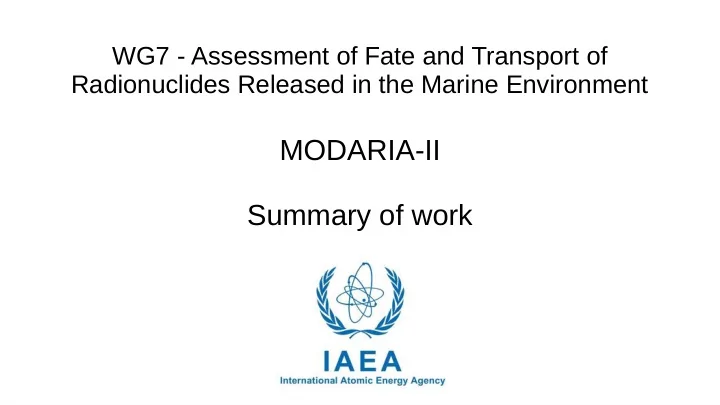

WG7 - Assessment of Fate and Transport of Radionuclides Released in the Marine Environment MODARIA-II Summary of work
Working Group: ● 11-15 participants ● Interim meetings in – Monaco – Vienna – Kiev
Work of the group ● Pacific Ocean scenario: Fukushima releases ● Marine kds and water/sediment interactions ● Generic NPP scenario (WG3) ● Atlantic Ocean (historical releases from reprocessing facilities) ● Numerical schemes in Lagrangian models ● Final Report
Three papers published R. Periáñez, R. Bezhenar, I. Brovchenko, K.T. Jung, Y. Kamidara, K.O.Kim, T. Kobayashi, L. ● Liptak, V. Maderich, B.I. Min, K.S. Suh, 2019. Fukushima 137Cs releases dispersion modelling over the Pacific Ocean. Comparisons of models with water, sediment and biota data. Journal of Environmental Radioactivity 198, 50-63. R. Periáñez, I. Brovchenko, K.T. Jung, K.O. Kim, V. Maderich, 2018. The marine kd and ● water/sediment interaction problem. Journal of Environmental Radioactivity 192, 635-647. Periáñez, R., Bezhenar, R., Brovchenko, I., Duffa, C., Iosjpe, M., Jung, K.T., Kim, K.O., ● Kobayashi, T., Liptak, L., Maderich, V., McGuinnity, P., Min, B.I., Nies, H., Osvath, I., Suh, K.S., de With, G., 2019 Marine radionuclide dispersion modelling: recent developments, problems and challenges. Environmental Modelling & Software 122, 104523. Review paper.
Fukushima scenario Example of surface deposition, March 15, Direct releases (JAEA) (JAEA, KAERI)
Simulations FORA model surface circulation (March 2011) Box definition for model comparisons Simulations: two year-long; monthly mean circulations Transport models include an integrated BUM (3 types: equilibrium, dynamic, allometric) Model results compared with measurements in water (3 layers) sediment and biota (4 species)
Sampling points
Surface water
Zooplankton and non-piscivorous fish Zooplankton Non-piscivorous fish
Marine kd and water/sediment interactions When k d s are measured in the sea, samples should be taken as far as possible from radionuclide ● releases: equilibrium in sediment/water tracer partition does not exist in the release area. Kd model not applicable here. Distribution coefficients for suspended sediments and for seabed sediment may vary in orders of ● magnitude being all the environmental conditions and particle properties identical. It is essential to know how these measurements in sediments are carried out, i.e., only the readily ● exchangeable phase is extracted or not. In the initial phase of an accidental radionuclide release, 1-step and 2-step models produce essentially the ● same results. Thus, for rapid radioactive assessments after an emergency a 1-step model may be adequate. However, a 2-step model should be better used for longer-term calculations. A multi-layer model is required to evaluate sediment inventories of radionuclides; but a single-layer model, ● adequately tuned, may produce satisfactory results for radionuclide concentrations in the surface sediment. This is generally the case for radioactive assessments after accidents. As a general conclusion for the assessment of radioactive emergencies, which imply short temporal ● scales, it should be recommended to have available site-specific values of kinetic rates which could be used in radionuclide transport models. A semi-empirical equation has been proposed to modulate the freshwater adsorption kinetic rate, k 1 , due ● to changes in salinity and pH
Generic NPP scenario. Releases in the Atlantic Coast of the US (WG3 scenario) USEV contiguration Three models: POSEIDON-R (IMMSP) Specific box model (USEV) Eulerian ESTE (ABmerit) Radionuclide discharges for year 2016 were provided by WG3 POSEIDON-R configuration All required inputs from literature search (depths, water currents and fluxes, SPM, sedimentation rates…) by each modelling team Completely blind model comparisons
Results: calculated concentrations in water and sediments around the NPP
Atlantic Ocean: historical releases from reprocessing plants Example of surface circulation from JAMSTEC OFES model (Ocean global circulation model For the Earth Simulator). Mean monthly values are used. 137-Cs releases -Simulations about 50 year-long -BUM included in transport models -Models compared with measurements in MARIS database
Example: south Norwegian Sea But OFES does not correctly solve flux through North Strait. Other options tested:
HYCOM results south North Sea Measurements: MARIS database Surface water Deep water Sediment Dover Strait flux is not correctly solved FIOCOM model (First Institute of Oceanography, China) does not improve Too coarse resolution? Tide residuals in the Irish Sea are relevant?
Numerical schemes in Lagrangian models r ( t +Δ t )=⃗ r ( t )+⃗ q Δ t ⃗ One dimensional transport in a tidal channel Compare interpolation schemes Effect of dx when concentrations are calculated
Model comparisons Single particle: Initial deposition and mixing added:
Final Report 1) Introduction 2) Fukushima NPP accident scenario. Large scale simulations and biota transfer of 137-Cs 3) The water/sediment interaction problem 4) Atlantic Ocean scenario: historical releases from European nuclear fuel reprocessing facilities 5) Testing numerical interpolation schemes in Lagrangian models. Preliminary results 6) Generic NPP scenario 7) General recommendations for the use of models in radioactive assessments after accidents in the marine environment and determination and use of kds 8) Conclusions 9) Annex: Models applied to the generic NPP scenario
Recommend
More recommend